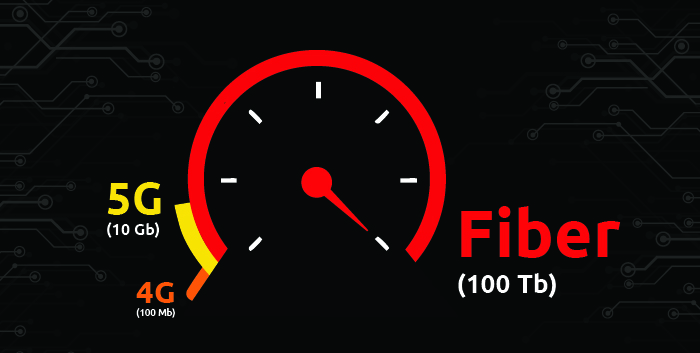How MPLS Networks Help Streamline Business Operations in Broadcasting and Internet Services
Discover how MPLS technology delivers the reliability, performance, and quality of service that modern media and internet businesses demand.
Understanding MPLS Networks: The Backbone of Modern Broadcasting
In today's digital-first world, the seamless delivery of content—whether it's high-definition video streaming, real-time financial data, or mission-critical cloud applications—depends entirely on the invisible infrastructure connecting your business to your customers. At the heart of this infrastructure for many successful media and internet service providers sits a technology that, while not always in the spotlight, powers the experiences we've come to expect: Multiprotocol Label Switching (MPLS) networks.
But what exactly is MPLS, and why has it become so crucial for broadcasting companies and internet service providers? Let's break it down.
What is MPLS and How Does It Work?
MPLS is a routing technique that directs data from one network node to the next based on short path labels rather than complex network addresses. Think of it as an express lane on a highway—instead of stopping at every intersection to check directions (as traditional IP routing does), MPLS creates predetermined paths through the network, allowing data packets to travel faster and more efficiently.
Here's what makes it special:
- Packet forwarding: MPLS adds a label to each data packet that contains instructions about how to forward it through the network
- Predetermined paths: Traffic follows optimized routes that are established in advance
- Traffic engineering: Network administrators can specify exact paths for different types of traffic
- Protocol independence: As the name suggests, it works with virtually any network protocol
When you send data across an MPLS network, the first router (called a Label Edge Router or LER) examines the packet and assigns it a label. From that point forward, other routers in the path (Label Switch Routers or LSRs) only need to read this simple label to know where to send the packet next—no time-consuming routing table lookups required.
Key Components of an MPLS Network Architecture
An effective MPLS implementation relies on several critical components working in harmony:
1. Label Edge Routers (LERs) These devices sit at the boundary of the MPLS network, where they:
- Apply labels to incoming packets
- Remove labels from outgoing packets
- Connect the MPLS network to external networks
2. Label Switch Routers (LSRs) These form the core of the MPLS network and:
- Forward packets based solely on their labels
- Swap labels as packets move through the network
- Maintain label forwarding tables rather than routing tables
3. Label Distribution Protocol (LDP) This protocol establishes communication between routers by:
- Creating a standardized way for routers to exchange label information
- Establishing Label Switched Paths (LSPs)
- Maintaining the mapping between labels and destinations
4. Class of Service (CoS) Mechanisms These enable prioritization by:
- Categorizing different types of traffic
- Assigning appropriate quality of service levels
- Ensuring time-sensitive traffic (like video) gets priority
For broadcasting and internet service providers, understanding these components isn't just technical trivia—it's essential knowledge for building networks that can deliver on increasingly demanding customer expectations.
The Evolution from Traditional IP Routing to Label Switching
To appreciate MPLS fully, it helps to understand what came before it. Traditional IP routing works by examining the destination address of each packet at every router along its path. Each router makes an independent decision about where to send the packet next based on its routing tables.
This approach has several limitations:
- Inefficient path selection: Packets follow the shortest path according to routing protocols, which isn't always optimal for overall network performance
- Limited traffic management: Traditional routing provides few tools for prioritizing different types of traffic
- Unpredictable performance: Network congestion can cause unpredictable delays that are problematic for time-sensitive applications
- Complex QoS implementation: Ensuring quality of service across diverse traffic types is challenging
MPLS addresses these limitations by separating the routing decision (which happens once, at the edge of the network) from the forwarding process (which happens multiple times as the packet traverses the network). This fundamental shift revolutionized how networks handle traffic, particularly for applications where performance, reliability, and predictability are non-negotiable—like broadcasting live events or delivering streaming content.
Business Benefits of MPLS for Internet and Broadcasting Services
The technical advantages of MPLS translate into tangible business benefits that directly impact the bottom line for media companies and internet service providers. Let's explore how MPLS creates operational efficiencies that can transform your business.
Enhanced Network Performance and Reliability for Media Delivery
When you're in the business of delivering content—whether it's live sports, breaking news, or binge-worthy entertainment—network performance isn't just a technical specification; it's the foundation of your customer experience. MPLS delivers several critical performance enhancements:
Reduced Latency By eliminating the need for complex routing decisions at each hop, MPLS significantly reduces the time data packets spend traversing the network. For broadcasting operations, this means:
- Lower delay between camera and viewer
- More responsive interactive applications
- Smoother live broadcasts with fewer technical glitches
Consistent Performance Unlike the public internet, where performance can vary wildly depending on conditions beyond your control, MPLS networks offer predictable performance characteristics:
- Stable bandwidth availability
- Consistent round-trip times
- Reliable packet delivery with minimal loss
For a major broadcaster covering a live event, this consistency can be the difference between delighted viewers and a social media backlash over buffering and quality issues.
Network Uptime MPLS networks typically include built-in redundancy and fast rerouting capabilities:
- Automatic failover when links go down
- Sub-second rerouting around network problems
- Multiple paths for critical traffic
This translates to fewer outages, minimal service disruptions, and greater overall business continuity—essential for services where even brief downtime can drive customers to competitors.
Quality of Service (QoS) Controls for Time-Sensitive Content
Perhaps the most significant advantage MPLS offers to broadcasting and internet service companies is its robust Quality of Service capabilities. Not all network traffic is created equal—a video frame for a live broadcast is far more time-sensitive than an email attachment.
MPLS enables sophisticated traffic prioritization through:
Traffic Classification MPLS networks can identify different types of traffic and handle them accordingly:
- Video streams receive highest priority
- Voice traffic gets expedited forwarding
- Data transfers use available bandwidth without interfering with more critical traffic
Bandwidth Guarantees For mission-critical applications, MPLS can provide guaranteed minimum bandwidth:
- Live event broadcasts receive committed bandwidth regardless of other network traffic
- Video on demand services maintain consistent quality during peak viewing hours
- Business operations maintain necessary connectivity even during high-demand periods
Latency Control Time-sensitive applications benefit from MPLS's ability to minimize and control latency:
- Interactive applications remain responsive
- Two-way communications maintain natural conversational flow
- Synchronization issues in multi-camera productions are minimized
For a broadcasting company, these QoS capabilities translate directly into better viewer experiences, which drives engagement, retention, and ultimately, revenue.
Simplified Network Management and Operations
Beyond performance benefits, MPLS can significantly streamline network operations, reducing the administrative burden on your technical teams:
Centralized Control MPLS networks typically feature centralized management platforms that provide:
- Unified visibility across the entire network
- Simplified configuration of network-wide policies
- Easier troubleshooting when issues arise
Reduced Complexity By abstracting away some of the complexity of traditional routing, MPLS simplifies:
- Network design and implementation
- Traffic engineering decisions
- Day-to-day network operations
Operational Efficiency These management advantages translate to operational benefits:
- Faster resolution of network issues
- More efficient use of technical staff
- Lower operating costs over time
For IT directors and network operations teams, these efficiencies mean more time focused on innovation and less time putting out fires—a welcome shift in any organization.
Scalability Solutions for Growing Media Businesses
Media businesses rarely stand still—they grow, expand into new markets, launch new services, and adapt to changing audience demands. MPLS provides scalability advantages that support this constant evolution:
Easy Site Addition Adding new locations to an MPLS network is relatively straightforward:
- New studios can be integrated quickly
- Remote broadcasting locations can be brought online with minimal configuration
- Mergers and acquisitions can be technically integrated more smoothly
Capacity Expansion When audience growth drives bandwidth needs, MPLS networks can scale up:
- Bandwidth can often be increased without physical infrastructure changes
- Traffic prioritization ensures critical services remain unaffected during growth
- Expansion can happen incrementally rather than requiring "forklift upgrades"
Service Evolution As your business evolves, MPLS networks can adapt to new service offerings:
- New content delivery methods can be accommodated
- Emerging technologies can be integrated
- Business pivots can be supported without wholesale network redesigns
This scalability ensures your network infrastructure supports your business strategy rather than constraining it—a critical consideration in the fast-moving media landscape.
MPLS Implementation Strategies for Broadcasting and ISPs
Implementing an MPLS network requires careful planning and execution. For broadcasting companies and internet service providers, getting the implementation right is particularly crucial given the potential impact on customer experience.
Assessing Current Network Infrastructure
Before diving into MPLS implementation, a thorough assessment of your existing network infrastructure is essential:
Traffic Analysis Understanding your current traffic patterns helps design an optimal MPLS solution:
- What types of traffic dominate your network?
- When do peak periods occur?
- Which applications are most sensitive to network performance?
Pain Point Identification Identifying specific network challenges guides implementation priorities:
- Are you experiencing congestion during live broadcasts?
- Do you have reliability issues at certain network points?
- Are particular services suffering quality degradation?
Resource Evaluation Assessing available resources helps determine implementation scope:
- What existing equipment can be repurposed?
- What level of in-house expertise is available?
- What budget constraints must be considered?
This assessment phase prevents costly missteps and ensures your MPLS implementation addresses your most pressing business needs.
Planning for a Successful MPLS Migration
With assessment complete, detailed planning becomes the focus:
Network Design Creating a comprehensive network design includes:
- Determining optimal network topology
- Planning traffic engineering strategies
- Designing QoS policies aligned with business priorities
- Establishing redundancy and failover mechanisms
Migration Strategy Transitioning to MPLS while maintaining operations requires careful planning:
- Phased implementation to minimize disruption
- Testing protocols to validate each implementation stage
- Rollback procedures in case of unexpected issues
- Staff training to ensure operational readiness
Success Metrics Defining clear success criteria ensures you can measure implementation effectiveness:
- Network performance benchmarks
- Service quality improvements
- Operational efficiency gains
- Return on investment calculations
A well-executed planning phase creates a roadmap that guides implementation while managing risk and setting realistic expectations.
Working with MPLS Service Providers
Most broadcasting and internet service companies work with MPLS service providers rather than building their own networks from scratch. Selecting and managing these relationships effectively is crucial:
Provider Selection Choosing the right MPLS provider involves evaluating:
- Geographic coverage that matches your operational footprint
- Service level agreements (SLAs) that align with your business requirements
- Technical capabilities that support your specific use cases
- Pricing structures that deliver value while meeting budget constraints
Integration Planning Working effectively with providers requires integration planning:
- Clear demarcation points between provider and customer responsibilities
- Coordination of implementation timelines
- Alignment on monitoring and management approaches
- Communication protocols for service issues
Ongoing Management After implementation, effective provider management includes:
- Regular service reviews to ensure SLA compliance
- Performance optimization collaborations
- Capacity planning for future needs
- Technology roadmap discussions to stay ahead of industry trends
The right provider relationship transforms MPLS from a technical implementation to a strategic partnership that supports your business objectives.
MPLS for IPTV and Live Broadcast Delivery
For companies in the broadcasting space, MPLS offers specific advantages for IPTV delivery and live broadcasting—two areas where network performance directly impacts the end-user experience.
Ensuring Consistent Video Quality Across Delivery Networks
Viewers have increasingly high expectations for video quality, regardless of device or location. MPLS helps meet these expectations through:
End-to-End Quality Management MPLS provides tools to maintain quality throughout the delivery chain:
- Consistent packet prioritization across the network
- Bandwidth guarantees for video streams
- Performance monitoring at key points
Adaptive Bitrate Support Modern video delivery often uses adaptive bitrate streaming, which MPLS can enhance:
- Stable network performance reduces the need for quality downshifts
- Consistent delivery of manifest files ensures smooth adaptation
- Reduced packet loss prevents quality degradation during adaptation
Multi-Platform Delivery As content consumption spreads across devices, MPLS helps maintain consistency:
- Standardized quality regardless of delivery endpoint
- Efficient multicast for live content to multiple platforms
- Consistent experience across mobile, desktop, and smart TV environments
These capabilities help broadcasting companies deliver on their quality promises—an increasingly important competitive differentiator in a crowded content landscape.
Reducing Latency for Live Event Broadcasting
Live events represent the most demanding broadcasting scenario, where even minor latency issues can significantly impact viewer experience. MPLS excels in this environment by:
Minimizing Processing Delays The simplified forwarding mechanism of MPLS reduces latency at each network hop:
- Label-based forwarding is faster than traditional routing
- Predetermined paths eliminate routing decisions
- Traffic engineering optimizes paths for minimal delay
Prioritizing Time-Sensitive Traffic MPLS can elevate the priority of live broadcasts:
- Real-time streams receive preferential treatment
- Non-time-sensitive traffic yields to live content
- Expedited forwarding ensures minimal queuing delay
Synchronization Support For complex productions involving multiple feeds, MPLS helps maintain synchronization:
- Consistent latency across different transmission paths
- Precise timing for multi-camera productions
- Reliable transport for timing signals
These capabilities enable broadcasters to deliver immersive live experiences that feel truly "live" rather than noticeably delayed—a subtle but important quality factor for sports, news, and event broadcasting.
Managing Peak Bandwidth During High-Viewership Events
Major sporting events, breaking news, and popular program premieres can create enormous spikes in viewership that stress network infrastructure. MPLS provides tools to manage these peak demand periods:
Dynamic Bandwidth Allocation MPLS networks can adapt to changing demand patterns:
- Reallocation of resources during high-demand events
- Temporary prioritization of specific content streams
- Flexibility to adjust to unexpected viewership spikes
Traffic Engineering for Peak Periods Advance planning for known high-demand events becomes possible:
- Special traffic paths for major broadcasts
- Temporarily expanded capacity allocations
- Customized QoS policies for specific events
Graceful Degradation Strategies When demand exceeds capacity, MPLS allows for controlled service adjustment:
- Prioritization of paying subscribers during extreme peaks
- Selective quality reduction rather than service failure
- Protection of critical business services while managing consumer traffic
This peak management capability provides a significant competitive advantage, allowing media companies to maintain service quality during exactly the high-profile moments when viewers are most engaged and expectations are highest.
Monitoring and Optimizing MPLS Networks
Implementing an MPLS network is just the beginning—ongoing monitoring and optimization are essential to realize its full potential. For broadcasting and internet service companies, this operational aspect is particularly crucial given the direct connection between network performance and customer experience.
Essential MPLS Network Monitoring Tools and Approaches
Effective monitoring requires the right tools and methodologies:
Network Performance Monitoring Comprehensive visibility into network behavior requires:
- End-to-end performance measurement
- Detailed metrics on latency, jitter, and packet loss
- Real-time monitoring dashboards for operations teams
- Historical trend analysis for capacity planning
Service-Level Monitoring Beyond raw network metrics, monitoring should focus on service quality:
- Video stream quality measurements
- Customer experience metrics
- Application performance indicators
- Service availability tracking
Proactive Alert Systems Identifying issues before they impact service requires:
- Intelligent thresholding based on historical patterns
- Early warning indicators for developing problems
- Automated alerts to appropriate response teams
- Escalation protocols for critical issues
These monitoring capabilities transform network management from reactive troubleshooting to proactive optimization—a shift that both improves service quality and reduces operational stress.
Key Performance Metrics for Broadcast-Quality Service
Not all network metrics are equally relevant for broadcasting applications. Focus on these key indicators:
Video-Specific Metrics For content delivery, specialized measurements matter:
- Mean Opinion Score (MOS) for perceived video quality
- Video packet loss rate
- Stream initialization time
- Buffering ratio during playback
Network Foundation Metrics Underlying these application metrics are fundamental network measurements:
- Round-trip time (RTT) across critical network paths
- Jitter (variation in packet delay)
- Packet delivery ratio
- Available vs. utilized bandwidth
Business Impact Metrics Ultimately, these technical measurements should connect to business outcomes:
- Customer satisfaction scores
- Content consumption duration
- Subscriber retention rates
- Service call volumes related to quality issues
By focusing monitoring efforts on these key metrics, technical teams can ensure they're optimizing for outcomes that matter to the business rather than chasing technical perfection for its own sake.
Troubleshooting Common MPLS Issues in Media Delivery
Even well-designed MPLS networks encounter issues. Efficient troubleshooting processes focus on common problems:
Congestion Identification Network congestion often manifests as:
- Increased latency during peak periods
- Buffer bloat at network interconnection points
- Packet loss under high load conditions
- QoS policy violations
Path Problems Issues with specific network paths may appear as:
- Asymmetric routing causing unpredictable performance
- Label distribution failures creating forwarding gaps
- LSP establishment failures limiting available paths
- MTU mismatches causing fragmentation issues
Provider Handoff Challenges When multiple providers are involved, watch for:
- SLA violations at provider boundaries
- Inconsistent QoS implementation between providers
- Class of Service mapping discrepancies
- Monitoring gaps at network edges
Having structured approaches to these common issues reduces mean time to resolution and minimizes service impacts—critical for maintaining viewer satisfaction and business continuity.
Case Studies: MPLS Success Stories in Broadcasting
Abstract discussions of MPLS benefits are valuable, but real-world examples bring these advantages to life. While specific company names have been anonymized to respect confidentiality, these case studies illustrate actual implementations and outcomes.
Major Network's Infrastructure Transformation
A leading national broadcasting network faced increasing challenges with their legacy infrastructure as they expanded their digital offerings:
Challenge:
- Aging point-to-point connections between 12 regional studios and 3 production centers
- Inconsistent quality during peak broadcasting hours
- Inability to quickly establish connections for remote broadcasting
- Rising costs as more dedicated links were added
MPLS Solution:
- Implemented a fully-meshed MPLS network connecting all facilities
- Established tiered QoS policies prioritizing live broadcasts
- Created dynamic capacity allocation for special events
- Integrated cloud resources for overflow processing
Results:
- 40% reduction in video transmission latency
- 99.997% network availability (up from 99.8%)
- 28% decrease in total network operating costs
- Ability to establish new remote locations within hours instead of weeks
This transformation enabled the network to launch new digital services while improving traditional broadcast quality—a dual benefit that directly enhanced their competitive position.
Regional ISP's Performance Improvements
A regional internet service provider offering residential and business connectivity alongside IPTV services struggled with service quality during peak viewing hours:
Challenge:
- Customer complaints about evening streaming quality
- Inefficient utilization of available bandwidth
- Difficulty maintaining consistent service levels across their service area
- Growing subscriber base straining existing infrastructure
MPLS Solution:
- Redesigned backbone using MPLS traffic engineering
- Implemented advanced QoS to prioritize streaming during peak hours
- Deployed comprehensive monitoring with automated remediation
- Established faster failover mechanisms for link problems
Results:
- 76% reduction in streaming-related customer complaints
- 35% improvement in peak-hour video quality metrics
- More efficient bandwidth utilization allowing subscriber growth without proportional capacity expansion
- Reduced operational expenses through automated optimization
These improvements allowed the ISP to increase their subscriber base while simultaneously improving service quality—driving both top-line revenue growth and improved customer retention.
OTT Provider's Quality of Service Optimization
An emerging over-the-top content provider needed to compete with established players by delivering superior streaming quality:
Challenge:
- Limited control over last-mile delivery to subscribers
- Variable quality when delivering through multiple ISP partners
- Difficulty maintaining consistent user experience across regions
- Cost constraints as a growth-stage company
MPLS Solution:
- Established MPLS connections to major ISP peering points
- Created a content delivery architecture optimized for consistent quality
- Implemented advanced analytics to identify and address quality bottlenecks
- Used traffic engineering to optimize delivery paths during high-demand periods
Results:
- 52% improvement in average stream quality metrics
- 64% reduction in buffering events during new content releases
- More consistent experience across different internet service providers
- Ability to deliver premium 4K content with reliable performance
This quality advantage helped the provider differentiate in a crowded marketplace, resulting in subscriber growth that exceeded their business plan projections by 40%.
Future-Proofing: MPLS and Emerging Network Technologies
While MPLS offers significant advantages today, the networking landscape continues to evolve. Understanding how MPLS intersects with emerging technologies helps broadcasting and internet service companies make forward-looking infrastructure decisions.
MPLS and SD-WAN Integration Strategies
Software-Defined Wide Area Networking (SD-WAN) has emerged as a complementary technology to MPLS, not necessarily a replacement:
Hybrid Approaches Many organizations are finding value in combining MPLS and SD-WAN:
- MPLS for critical, performance-sensitive applications
- SD-WAN for branch connectivity and less demanding traffic
- Intelligent traffic steering between the two based on application requirements
- Unified management across both network types
Migration Considerations When evaluating SD-WAN alongside existing MPLS investments, consider:
- Application performance requirements and sensitivity to best-effort delivery
- Geographic reach and international connectivity needs
- Security requirements for different traffic types
- Total cost of ownership across various hybrid configurations
Implementation Best Practices Successful integration typically follows these principles:
- Phased deployment starting with non-critical locations
- Clear policies defining which traffic uses which transport
- Comprehensive monitoring across both network types
- Regular optimization based on performance analytics
Rather than viewing SD-WAN as an MPLS replacement, forward-thinking companies are leveraging both technologies' strengths in complementary deployments.
Cloud Services Integration with MPLS Networks
As media companies increasingly leverage cloud resources for production, distribution, and analytics, MPLS networks must evolve to support these hybrid architectures:
Direct Cloud Connectivity Modern MPLS implementations often include direct connections to cloud providers:
- Dedicated circuits to major cloud platforms
- Consistent performance for cloud-based workflows
- Secure connectivity without internet exposure
- Predictable costs compared to data transfer fees
Multi-Cloud Strategies As organizations adopt services across cloud providers, networks must adapt:
- Traffic engineering between different cloud environments
- Consistent security and performance policies across providers
- Centralized monitoring of hybrid environments
- Flexible bandwidth allocation as workloads shift
Edge Computing Integration The rise of edge computing creates new requirements for MPLS networks:
- Low-latency connections to edge processing nodes
- Distributed intelligence in the network layer
- Dynamic path selection based on workload location
- Seamless handoffs between edge and centralized resources
This cloud integration capability ensures MPLS remains relevant even as computing resources become more distributed and virtualized.
5G and the Future of Content Delivery Networks
The rollout of 5G networks is creating new possibilities for content delivery while also presenting integration challenges:
Mobile Edge Opportunities 5G's emphasis on edge computing creates new delivery architectures:
- Content caching at the mobile network edge
- Low-latency paths between MPLS backbones and 5G infrastructure
- New monetization opportunities for low-latency applications
- Enhanced mobile viewing experiences
Fixed Wireless Integration 5G fixed wireless access creates new network considerations:
- MPLS as reliable backhaul for 5G fixed wireless deployments
- New last-mile options for content delivery
- Hybrid approaches combining fiber and wireless access
- Extending broadcast-quality service to previously underserved areas
Technology Convergence 5G's network slicing concepts share philosophical similarities with MPLS:
- Quality-of-service guarantees across diverse network segments
- Traffic separation and prioritization
- End-to-end performance management
- Service-specific treatment of different traffic types
By understanding these emerging technologies and their interaction with MPLS, broadcasting and internet service companies can make infrastructure investments that remain valuable as the technology landscape evolves.
Conclusion: Maximizing MPLS Benefits for Your Broadcasting Business
In the fast-evolving world of media delivery, network infrastructure decisions have profound impacts on both operational efficiency and customer experience. MPLS networks, with their unique combination of performance guarantees, traffic management capabilities, and operational simplicity, continue to provide significant advantages for broadcasting companies and internet service providers.
Key Takeaways
As you consider your network strategy, remember these essential points about MPLS:
- Performance Differentiation: MPLS enables the consistent, high-quality service delivery that distinguishes premium media providers from commodity competitors.
- Operational Efficiency: Beyond technical benefits, MPLS networks can streamline operations, reduce troubleshooting complexity, and free technical teams to focus on innovation rather than maintenance.
- Future Compatibility: Rather than being replaced by newer technologies, MPLS is evolving to complement and integrate with SD-WAN, cloud services, and 5G networks.
- Business Alignment: The right MPLS implementation aligns network capabilities with business priorities, ensuring technical investments directly support strategic objectives.
- Implementation Matters: The benefits of MPLS aren't automatic—thoughtful design, careful implementation, and ongoing optimization are essential to realizing its full potential.
For media companies navigating digital transformation, MPLS provides a solid foundation that supports innovation while maintaining the reliability that viewers and subscribers expect. By understanding both the technical capabilities and business implications of this powerful networking approach, you can make informed infrastructure decisions that position your organization for long-term success.
Next Steps
If you're considering implementing or optimizing an MPLS network for your broadcasting or internet service business, consider these practical next steps:
- Assessment: Evaluate your current network performance against your business requirements, identifying specific gaps that MPLS might address.
- Education: Ensure your technical and business leadership understand both the capabilities and limitations of MPLS technology.
- Partner Evaluation: Research potential MPLS service providers with specific experience in media and broadcasting applications.
- Pilot Planning: Consider a limited deployment focusing on your most critical or problematic applications before a full implementation.
- Success Metrics: Define clear, measurable objectives that will help you evaluate the business impact of your MPLS investment.
By approaching MPLS strategically—as a business enabler rather than just a technical implementation—you can create network infrastructure that delivers tangible competitive advantages in the demanding world of media delivery.
FAQs About MPLS Networks for Broadcasting
What is the main difference between MPLS and traditional IP routing? MPLS uses label-based forwarding instead of IP address lookups at each hop. This simplifies and accelerates packet forwarding, reducing latency and enabling more predictable performance—critical factors for media delivery.
How does MPLS improve video streaming quality? MPLS enhances video streaming through guaranteed bandwidth allocation, traffic prioritization, reduced packet loss, and consistent low latency. These factors combine to deliver more stable video quality, faster start times, and fewer buffering events.
Is MPLS being replaced by SD-WAN? No, MPLS and SD-WAN are increasingly used together in complementary roles. MPLS typically handles performance-critical applications like live video, while SD-WAN provides flexible connectivity for less demanding traffic and branch locations.
What are the typical cost factors for MPLS implementation? MPLS costs include initial hardware investments, ongoing bandwidth charges (typically higher than internet connectivity), management overhead, and service provider fees. However, these costs should be weighed against the business value of improved service quality and operational efficiencies.
How can we monitor MPLS network performance? Effective MPLS monitoring combines specialized tools like network performance monitors, application-aware monitoring solutions, and video quality measurement systems. Leading practices include end-to-end visibility, comprehensive dashboards, and automated alerting based on business-relevant thresholds.
What security benefits does MPLS provide? MPLS inherently separates customer traffic, creating natural segregation between different organizations' data. Additionally, MPLS networks don't expose routing information to the public internet and can be combined with encryption for highly secure implementations.
How quickly can an MPLS network be implemented? Implementation timelines vary based on complexity and scale, but typically range from several weeks for basic configurations to 3-6 months for large, multi-site deployments. Cloud-based MPLS services can sometimes accelerate this timeline for certain applications.
Can MPLS handle our growth projections? MPLS networks are highly scalable in terms of both bandwidth and geographic reach. Working with established providers ensures capacity for future growth, though significant expansion may require advance planning and contractual considerations.
--
Pioneer Online & Pioneer Digital TV:
Seamless Internet + Endless Entertainment with Pioneer
Whether you’re working, learning, gaming, or binge-watching, Pioneer Online brings you the perfect combo of ultra-fast fiber broadband, 500+ live TV channels, and access to the top OTT platforms in India — all at unbeatable prices.
Serving homes, gated communities, and businesses across Hyderabad, Gachibowli, Madhapur, Kukatpally, and more.
- Trusted by many happy customers
- 24/7 customer support & lightning-fast activation
- Tailored broadband + TV plans for every lifestyle
Need help choosing the right plan?
- Compare all combo plans
- See our OTT & channel list
Call us at 040 4343 5353 for a free consultation.
Or WhatsApp us to get connected in just 24 hours!
Visit: www.pioneeronline.com
Entertainment Hub: www.pioneerdigitaltv.net



























































